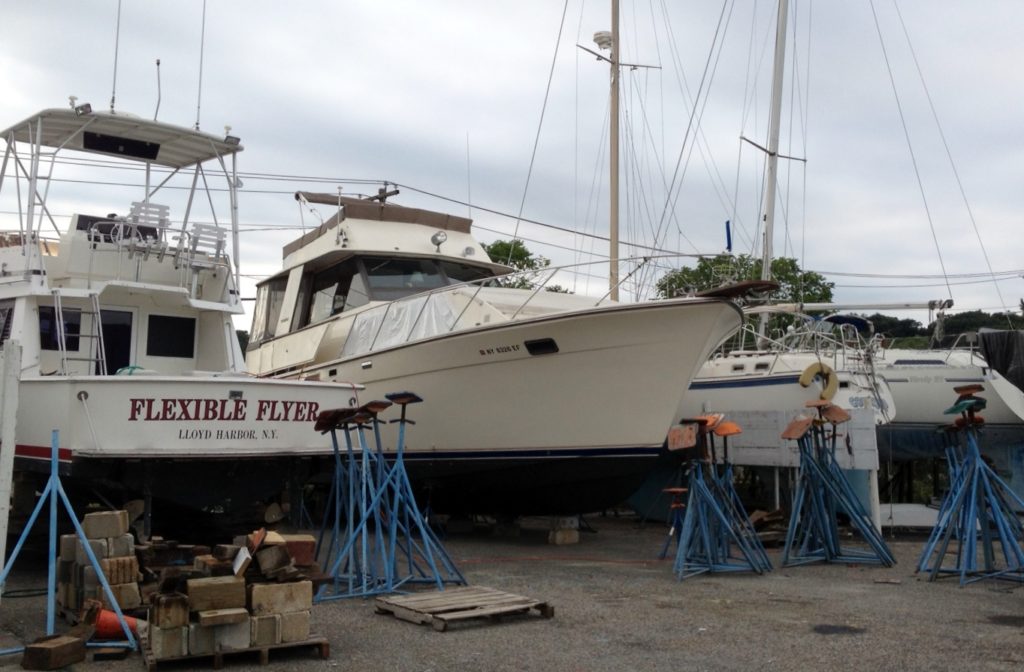We know this is a sensitive subject. Practically no boater wants to talk about winterizing. Primarily, winterizing means summer fun has ended, but it’s also a chore if you do it yourself. We can’t make the summer last forever, but we aim to make the task of protecting your boat from the cold and the elements a bit easier.
Where your boat spends the offseason dictates many steps. Options include bringing your boat home, having it hauled for inside or outside storage at a marina or boatyard, or keeping it in the water.
On blocks or jack stands
Though some boaters create their own cribbing, manufactured jack stands support the keel properly and make the boat less likely to be toppled by high winds or blowing snow. Ensure the stands are properly positioned, adequately stabilized, won’t cause deflection of the hull, and are secured with chains to prevent slipping. Don’t secure a tarp or canvas cover to the jack stands — gusty winds may wrench even the most stabilized vessel off its footing.
Indoor storage
While this is the least worrisome option, it’s wise to find out the marina or boatyard’s policy regarding spring launches before you schedule your haul. Storage configurations may dictate that boats stored earlier are the latest to launch in spring.

In the water
Close all seacocks.
Check rudder shafts and stuffing boxes for leaks; tighten or repack as necessary.
Remove hose connected to each seacock. While the hoses are disconnected, blow out each seacock with an air compressor — turn on the compressor, hold the hose in the seacock, cup one hand over the seacock to create a seal and open the seacock with the other hand. Depending on how close or loud the compressor, you can hear water bubbling under the boat. After five seconds, close the seacock and un-cup your hand. Wait a few minutes and then check each seacock for leaks. If none exist, securely tighten each hose.
Ensure the battery is fully charged. Clean the terminals, add water if necessary, and test that the charging system is working.
Clear out debris and ensure float switches properly activate on bilge pump.
If the marina or boatyard does not offer a de-icing device or bubbling system for stored vessels, install your own.
For all boats
These steps prevent deterioration and make it easier to get going in the spring.
Pump out the head’s holding tank at an approved facility.
Remove all valuables.
Wash and wax the vessel.
Clean interior carpets and floors.
Remove items that attract mildew, like life jackets and cushions.
Leave absorbent pads in the bilge to soak up oil.
Drain lines.
Remove lead-acid storage batteries. Store fully charged batteries in a well-ventilated, warm location on a nonconductive surface.
Leave the refrigerator and freezer doors open with boxes of baking soda inside.
Place moisture-absorbing products about the cabin. If the product comes in a bucket that could overflow, make a few small holes in the bottom and place in the sink.
Boaters disagree about the benefit of full fuel tanks over the winter. Consult with a mechanic or marina manager for their recommendation. Whether you fill up completely to avoid condensation or opt against storing a vessel full of fuel, add a fuel stabilizer for extra assurance.
On land or in water, boats stored outside need periodic visits, especially before and after storms. If your marina or boatyard doesn’t have winter personnel to update you, make the time to check.
Always consult your vessel’s owner’s manual for specific winter recommendations.
Sidebar
Create a To-Do List

Before you put boating out of your mind, create a to-do list of all the pesky projects you put off doing during the season as well as ones you want to do as time allows. Assess what was broken, faded, and torn over the season and what is due for an upgrade.
Note the where, the what, and the why of each task so that come early spring you don’t scratch your head and puzzle over entries like: New gasket.
Try to complete some tasks over the colder months, stock up on parts, and make service appointments so you’ll be on your way sooner in the spring!



